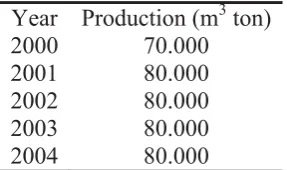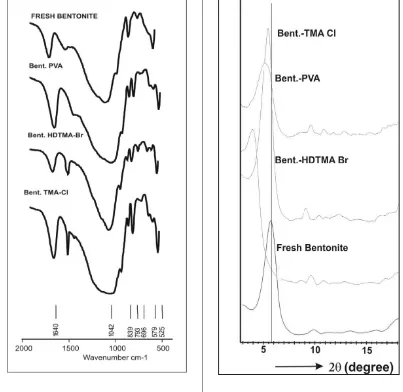International Journal of Materials Science
ISSN 0973-4589 Volume 8, Number 2 (2013), pp. 91-96 © Research India Publications
http://www.ripublication.com/ijoms.htm
Effect of the Surfactant Molecule as Intercalating
Agent toward Natural Bentonite Structure
ARIEF Budhyantoro1 and RESTU Kartiko Widi1,*
1
Department of Chemical Engineering, University of Surabaya, TG building 5th floor, Raya Kalirungkut,
Surabaya 60293, Indonesia *[email protected]
Abstract
Synthesis of organo-clay from natural bentonite with several surfactants using sol-gel methods has been conducted. The objective of this work is to modify the surface properties of the natural bentonite using several surfactants molecule. The modified materials can be further applied as composite materials, adsorbent and catalyst. The kind of surfactants which used on this work is HDTMA-Br (Hexadecyl Trimethyl Ammonium Bromide), TMA-Cl (Tetra methyl Ammonium Chloride) and PVA (Poly Vinyl Alcohol). The temperature for material synthesis was 80oC and it was agitated with hotplate magnetic stirrer for 5 hours. In order to characterize the structure of organo-clay that has been synthesized, X-ray diffraction and nitrogen adsorption with BET methods were performed. The XRD data showed that surfactant cause increasing of inter layer d-spacing of bentonite. The organo-clay that synthesized by intercalation bentonite using HDTMA-Br 0.75% showed the highest inter layer d-spacing, while intercalated bentonite uisng PVA and TMA-Cl described similar inter layer d-spacing. The pore size distribution of organo-clay was at micropore range, which was widest surface area and biggest pore volume showed by intercalated bentonite using TMA-Cl 0.75 %.
Keywords : bentonite, organoclay, intercalation, sol-gel methods
Introduction
92 ARIEF Budhyantoro and RESTU Kartiko Widi
relatively low-technology applications, it should be improved to be more valuable material, so that it has high-specification and high-value applications.
Table 1. Indonesia production of natural bentonite mining per-year from 2000 to 2004
The modification of bentonite and its study for some uses has attracted much interest in recent year. Bentonite able to growth its pore size based on its surrounding. It cause the bentonite has low adsorption and catalytic selectivity. To increase its selectivity, some modifications of bentonite have been done. One of the modifications is clay intercalation using organic molecules such as octadecylamine (ODA)[2] and hexadecyl trimethyl ammonium-bromide (HDTMA-Br)[3] as intercalating agent in interlayer vermiculite structure. The others surfactant materials have also been used as intercalating agent in smectite structure[4,5] H-herite structure[6] and bentonite structure[7].
The thermal stability of organoclay which was prepared from montmorillonite and N,N-dimethyl-N,N-dioctadecyl quaternary ammonium (DMDODA) as intercalating agent has also been studied[8]. The other researcher focuses on study the conformation of surfactant molecule on interlayer of montmorillonite[9].
This paper demonstrates the preparation and characterization of modified bentonite by intercalation and pillarisation using sol-gel method.
Experiment
The starting clay was a natural Pacitan bentonite, extracted from Pacitan region, East Java, Indonesia. The particle size of bentonite was 140 meshes. The intercalating agents were hexadecyl trimethyl ammonium-bromide (HDTMA-Br, Merck), polyvinyl alcohol (PVA, Merck), and tetramethyl ammonium chloride (TMA-Cl, Merck). The methods of pillarisation referred to sol-gel method that has been carried out before[7,10]. Pillarisation and intercalation process of the clay was carried out by mixing bentonite and intercalating agent solution with ratio [gram bentonite/ volume of solution] = 1 gram/50 mL. The mixture was agitated at 80oC. After 5 hours, the mixture was cooled and washed with aquadest. The obtained solid was dried at 100oC. All the materials were systematically characterized by Fourier Transform Infra Red
Effect of the Surfactant Molecule as Intercalating Agent 93
Result and Discussion
The materials obtained from pillarisation of bentonite were encoded below (see table 2).
Tabel 2. Catalyst materials code
Code Material Fresh bentonite Natural bentonite unmodified
Bent.-HDTMA-Br Intercalated bentonite using HDTMA-Br 0.75% Bent.-PVA Intercalated bentonite using PVA 0.75% Bent.-TMA Intercalated bentonite using TMA-Cl 0.75%
Figure 1 shows the comparison between fresh bentonite, intercalated bentonite. It shows that there are difference pattern absorption peak in the wave number region of 500 – 2000 cm-1.
The band at 500 – 600 cm-1 corresponds to the pore character of the intercalated bentonite. The sharp peak in the fresh bentonite reflects that in natural there is the pore structure in the fresh bentonite, but it does not stabile because of its swelling properties. The similar band at around this wavenumber for TMA Cl and Bent.-PVA were sharper and slightly shift. This indicates their pores structure relatively more stabile since the sharper peak reflects that the tetrahedral silica structure is formed between two bentonite layers. Phenomenon of pores structure formation is supported by the presence of band at the region of 1040–1200 cm-1 which is known to be assignable to O-Si-O and O-Al-O species[7,10-11]. The wider and the shifted band to the higher wavenumber in this region indicate that intercalation process of the surfactant TMA-Cl and PVA is successful. These processes cause the increment of the external stretching energy of O-Si-O and O-Al-O bonding. These indicate that the surfactants molecules have been adsorbed into interlayer of natural bentonite and created interaction with bentonite layers. In the case of HDTMA-Br as intercalating agent, it shows that the band at 500 – 700 cm-1 is similar with that of fresh bentonite. This phenomenon is also supported by the band at 1040 – 1200 cm-1 which is sharper than that of fresh bentonite. It indicates that HDTMA-Br molecules may not be absorbed optimally by bentonite. It might be because of the size of HDTMA-Br micelle is bigger than that of TMA-Cl and PVA.
Beside the FT-IR spectra, the easiest way to determine whether intercalation is successful is to record the X-ray diffraction pattern of intercalated bentonite. The main diffraction peak of fresh bentonite was detected at 2ș = 5.80 (as crystallite surface 001). Figure 2 shows that the diffraction peaks of intercalated bentonite using HDTMA-Br, TMA-Cl and PVA, were slightly shifted to the lower 2ș values. Shifting of 2ș values clearly suggests expansion of bentonite layer during intercalation process.
94 ARIEF Budhyantoro and RESTU Kartiko Widi
show that the pore distribution is still in micropores region, this figure describes that TM- Cl molecules may intercalate better than the other surfactants.
Nanostructuring is verified by microscopic inspection allowing studying locally the relevance of the intercalating agents for improvement of bentonite structure using SEM techniques. The SEM images of intercalated bentonite in figure 4 show that the porous structure of bentonite is improved by intercalation process using TMA-Cl and HDTMA-Br. SEM images of natural bentonite as shown in this figure reveal non-porous structure. On the other hand SEM images of bent.-TMACl reveal better non-porous structure than that of bent.-HDTMABr. It indicates that TMA molecules may introduce inside the bentonite layer easier than that of HDTMA-Br.
Figure 1. FTIR spectra of fresh bentonite and intercalated bentonite using PVA 0.75%, HDTMA-Br 0.75% and TMA-Cl 0.75%
Effect of the Surfactant Molecule as Intercalating Agent 95
Figure 3. The pore distribution and pore volume of fresh bentonite and intercalated bentonite using PVA 0.75%, HDTMA-Br 0.75% and TMA-Cl 0.75%
Figure 4. SEM images of fresh bentonite (A), and intercalated bentonite using TMA-Cl (B) and HDTMA-Br (C)
4. Conclusion
Study of the used of TMA-Cl, HDTMA-Br and PVA as intercalating agent for bentonite modification is successfully done. An interesting observation made during these experiments is that the results show effectively modified in bentonite. TMA-Cl shows the most effective surfactant as intercalating agent compare to that of PVA and HDTMA-Br. Further investigation of the application of the intercalated bentonite need to be carries out (such as it performance as composite materials, catalyst or adsorbent).
Acknowledgment
The authors wish to express their gratitude to Expertise Area Development Program
96 ARIEF Budhyantoro and RESTU Kartiko Widi
(EADP) of University of Surabaya (UBAYA) for the financial support of the project.
References
[1] http: www.Indexmundi.com/commodities/mineral/clays, accessed September 17th, 2010.
[2] Zdene K.W., Marta V., Monika K., Pavla C., Miroslav P., Clays Clay Min., 2003, 51 (5), 555–565
[3] Slade P.G., Gates W.P., Clays Clay Min., 2004, 52 (2), 204-210
[4] Deng Y., Dixon J.B., White G. N., Clays Clay Min., 2004, 51 (2), 150-161 [5] Imai Y., Nishimura S., Inukai Y., Tateyama H., Clays Clay Min,. 2003, 51 (2),
162–167
[6] Kosuge K., Singh S.P., Chem. Mater., 2000,12, 421-427
[7] Widi R.K., Budhyantoro A., Savitri E., J. Chem. Chem. Eng., 2009, 3 (4), 48-53
[8] Rick D.D., Jeffrey W.G., Thomas E.S., John H.C., Paul C.T., Hugh C.D.L.,
Clays Clay Min., 2004 (3), 350–356
[9] Hongping H., Ray L.F., Feng D., Jianxi Z., Xiaoyan W., Peng Y., Clays Clay Min., 2004, 52 (2), 171–179
[10] Widi R.K., Budhyantoro A., Riadi L., Int. J. Appl. Chem., 2009, 6 (1), 11-18 [11] Yuan Z.Y., Liu S.Q., Chen T.H., Wang J.Z., Li, H.X., J. Chem. Soc. Chem.


